BNV 7036: Sustainable Construction Practices Analysis Report
VerifiedAdded on 2019/10/18
|12
|5086
|142
Report
AI Summary
This report examines sustainable construction practices within the UK construction industry, which is a major consumer of natural resources. It explores the benefits and limitations of three key practices: BREEAM as an assessment method, the use of natural stone as a building material, and construction and demolition waste management. The report highlights the environmental advantages of natural stone, such as its durability and low carbon footprint, while also addressing limitations like quarrying and transportation impacts. It discusses BREEAM's role in assessing building sustainability, its advantages in promoting health and economic benefits, and its potential drawbacks. The report also touches on opportunities to mitigate climate change risks and enhance organizational status. Furthermore, the report covers construction and demolition waste management and includes a case study to analyze practical usage of sustainable construction practices.
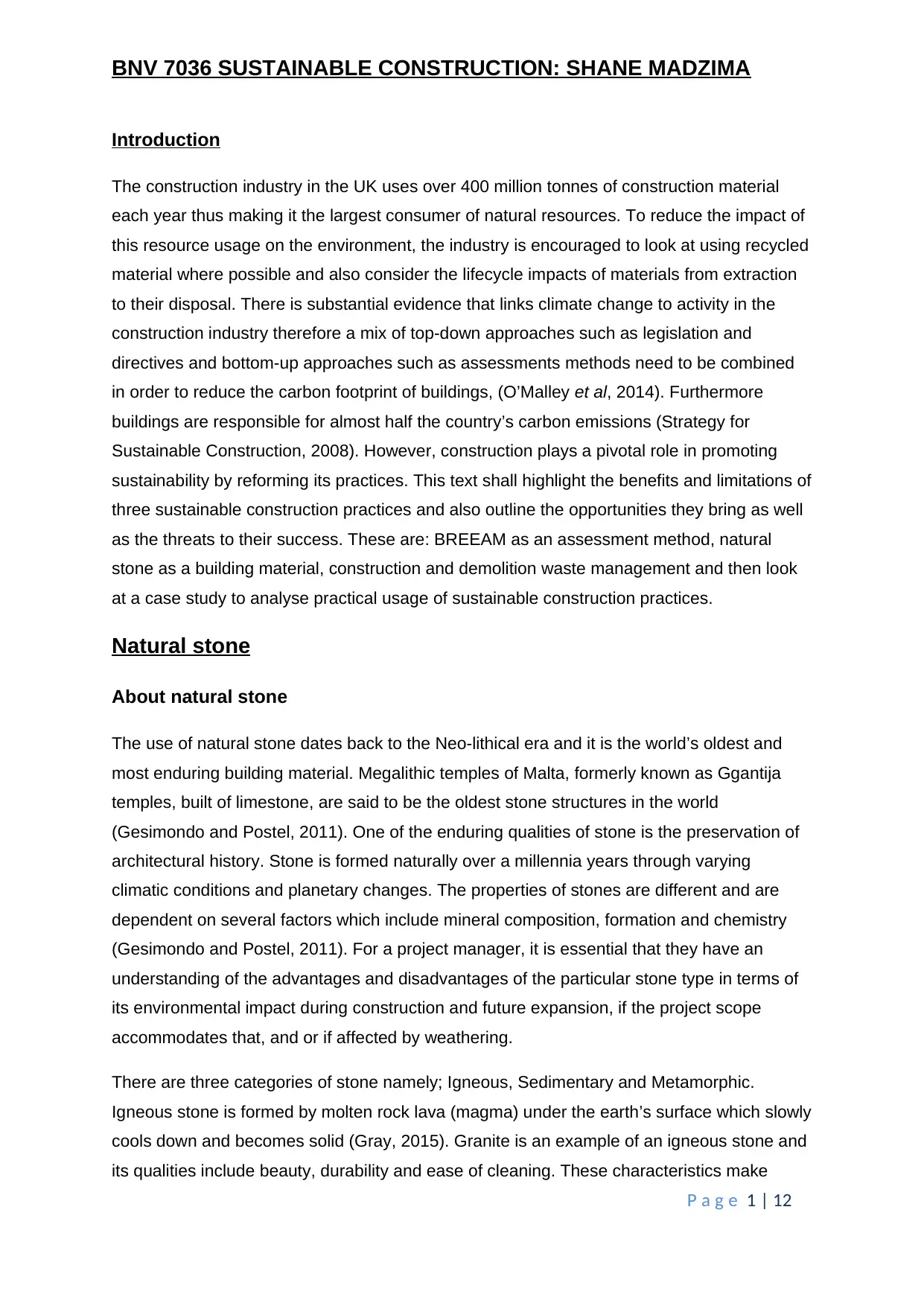
BNV 7036 SUSTAINABLE CONSTRUCTION: SHANE MADZIMA
Introduction
The construction industry in the UK uses over 400 million tonnes of construction material
each year thus making it the largest consumer of natural resources. To reduce the impact of
this resource usage on the environment, the industry is encouraged to look at using recycled
material where possible and also consider the lifecycle impacts of materials from extraction
to their disposal. There is substantial evidence that links climate change to activity in the
construction industry therefore a mix of top-down approaches such as legislation and
directives and bottom-up approaches such as assessments methods need to be combined
in order to reduce the carbon footprint of buildings, (O’Malley et al, 2014). Furthermore
buildings are responsible for almost half the country’s carbon emissions (Strategy for
Sustainable Construction, 2008). However, construction plays a pivotal role in promoting
sustainability by reforming its practices. This text shall highlight the benefits and limitations of
three sustainable construction practices and also outline the opportunities they bring as well
as the threats to their success. These are: BREEAM as an assessment method, natural
stone as a building material, construction and demolition waste management and then look
at a case study to analyse practical usage of sustainable construction practices.
Natural stone
About natural stone
The use of natural stone dates back to the Neo-lithical era and it is the world’s oldest and
most enduring building material. Megalithic temples of Malta, formerly known as Ggantija
temples, built of limestone, are said to be the oldest stone structures in the world
(Gesimondo and Postel, 2011). One of the enduring qualities of stone is the preservation of
architectural history. Stone is formed naturally over a millennia years through varying
climatic conditions and planetary changes. The properties of stones are different and are
dependent on several factors which include mineral composition, formation and chemistry
(Gesimondo and Postel, 2011). For a project manager, it is essential that they have an
understanding of the advantages and disadvantages of the particular stone type in terms of
its environmental impact during construction and future expansion, if the project scope
accommodates that, and or if affected by weathering.
There are three categories of stone namely; Igneous, Sedimentary and Metamorphic.
Igneous stone is formed by molten rock lava (magma) under the earth’s surface which slowly
cools down and becomes solid (Gray, 2015). Granite is an example of an igneous stone and
its qualities include beauty, durability and ease of cleaning. These characteristics make
P a g e 1 | 12
Introduction
The construction industry in the UK uses over 400 million tonnes of construction material
each year thus making it the largest consumer of natural resources. To reduce the impact of
this resource usage on the environment, the industry is encouraged to look at using recycled
material where possible and also consider the lifecycle impacts of materials from extraction
to their disposal. There is substantial evidence that links climate change to activity in the
construction industry therefore a mix of top-down approaches such as legislation and
directives and bottom-up approaches such as assessments methods need to be combined
in order to reduce the carbon footprint of buildings, (O’Malley et al, 2014). Furthermore
buildings are responsible for almost half the country’s carbon emissions (Strategy for
Sustainable Construction, 2008). However, construction plays a pivotal role in promoting
sustainability by reforming its practices. This text shall highlight the benefits and limitations of
three sustainable construction practices and also outline the opportunities they bring as well
as the threats to their success. These are: BREEAM as an assessment method, natural
stone as a building material, construction and demolition waste management and then look
at a case study to analyse practical usage of sustainable construction practices.
Natural stone
About natural stone
The use of natural stone dates back to the Neo-lithical era and it is the world’s oldest and
most enduring building material. Megalithic temples of Malta, formerly known as Ggantija
temples, built of limestone, are said to be the oldest stone structures in the world
(Gesimondo and Postel, 2011). One of the enduring qualities of stone is the preservation of
architectural history. Stone is formed naturally over a millennia years through varying
climatic conditions and planetary changes. The properties of stones are different and are
dependent on several factors which include mineral composition, formation and chemistry
(Gesimondo and Postel, 2011). For a project manager, it is essential that they have an
understanding of the advantages and disadvantages of the particular stone type in terms of
its environmental impact during construction and future expansion, if the project scope
accommodates that, and or if affected by weathering.
There are three categories of stone namely; Igneous, Sedimentary and Metamorphic.
Igneous stone is formed by molten rock lava (magma) under the earth’s surface which slowly
cools down and becomes solid (Gray, 2015). Granite is an example of an igneous stone and
its qualities include beauty, durability and ease of cleaning. These characteristics make
P a g e 1 | 12
Secure Best Marks with AI Grader
Need help grading? Try our AI Grader for instant feedback on your assignments.
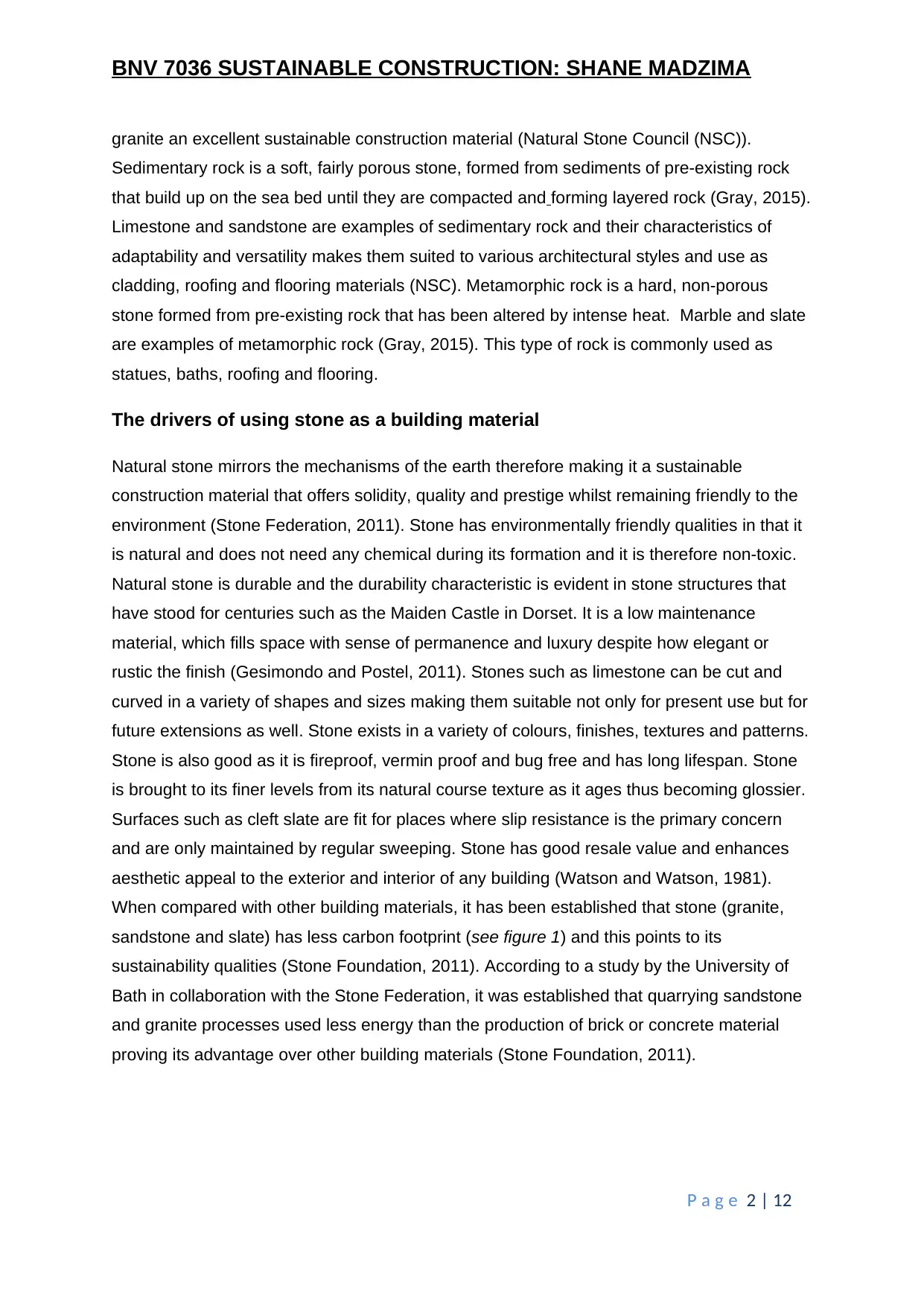
BNV 7036 SUSTAINABLE CONSTRUCTION: SHANE MADZIMA
granite an excellent sustainable construction material (Natural Stone Council (NSC)).
Sedimentary rock is a soft, fairly porous stone, formed from sediments of pre-existing rock
that build up on the sea bed until they are compacted and forming layered rock (Gray, 2015).
Limestone and sandstone are examples of sedimentary rock and their characteristics of
adaptability and versatility makes them suited to various architectural styles and use as
cladding, roofing and flooring materials (NSC). Metamorphic rock is a hard, non-porous
stone formed from pre-existing rock that has been altered by intense heat. Marble and slate
are examples of metamorphic rock (Gray, 2015). This type of rock is commonly used as
statues, baths, roofing and flooring.
The drivers of using stone as a building material
Natural stone mirrors the mechanisms of the earth therefore making it a sustainable
construction material that offers solidity, quality and prestige whilst remaining friendly to the
environment (Stone Federation, 2011). Stone has environmentally friendly qualities in that it
is natural and does not need any chemical during its formation and it is therefore non-toxic.
Natural stone is durable and the durability characteristic is evident in stone structures that
have stood for centuries such as the Maiden Castle in Dorset. It is a low maintenance
material, which fills space with sense of permanence and luxury despite how elegant or
rustic the finish (Gesimondo and Postel, 2011). Stones such as limestone can be cut and
curved in a variety of shapes and sizes making them suitable not only for present use but for
future extensions as well. Stone exists in a variety of colours, finishes, textures and patterns.
Stone is also good as it is fireproof, vermin proof and bug free and has long lifespan. Stone
is brought to its finer levels from its natural course texture as it ages thus becoming glossier.
Surfaces such as cleft slate are fit for places where slip resistance is the primary concern
and are only maintained by regular sweeping. Stone has good resale value and enhances
aesthetic appeal to the exterior and interior of any building (Watson and Watson, 1981).
When compared with other building materials, it has been established that stone (granite,
sandstone and slate) has less carbon footprint (see figure 1) and this points to its
sustainability qualities (Stone Foundation, 2011). According to a study by the University of
Bath in collaboration with the Stone Federation, it was established that quarrying sandstone
and granite processes used less energy than the production of brick or concrete material
proving its advantage over other building materials (Stone Foundation, 2011).
P a g e 2 | 12
granite an excellent sustainable construction material (Natural Stone Council (NSC)).
Sedimentary rock is a soft, fairly porous stone, formed from sediments of pre-existing rock
that build up on the sea bed until they are compacted and forming layered rock (Gray, 2015).
Limestone and sandstone are examples of sedimentary rock and their characteristics of
adaptability and versatility makes them suited to various architectural styles and use as
cladding, roofing and flooring materials (NSC). Metamorphic rock is a hard, non-porous
stone formed from pre-existing rock that has been altered by intense heat. Marble and slate
are examples of metamorphic rock (Gray, 2015). This type of rock is commonly used as
statues, baths, roofing and flooring.
The drivers of using stone as a building material
Natural stone mirrors the mechanisms of the earth therefore making it a sustainable
construction material that offers solidity, quality and prestige whilst remaining friendly to the
environment (Stone Federation, 2011). Stone has environmentally friendly qualities in that it
is natural and does not need any chemical during its formation and it is therefore non-toxic.
Natural stone is durable and the durability characteristic is evident in stone structures that
have stood for centuries such as the Maiden Castle in Dorset. It is a low maintenance
material, which fills space with sense of permanence and luxury despite how elegant or
rustic the finish (Gesimondo and Postel, 2011). Stones such as limestone can be cut and
curved in a variety of shapes and sizes making them suitable not only for present use but for
future extensions as well. Stone exists in a variety of colours, finishes, textures and patterns.
Stone is also good as it is fireproof, vermin proof and bug free and has long lifespan. Stone
is brought to its finer levels from its natural course texture as it ages thus becoming glossier.
Surfaces such as cleft slate are fit for places where slip resistance is the primary concern
and are only maintained by regular sweeping. Stone has good resale value and enhances
aesthetic appeal to the exterior and interior of any building (Watson and Watson, 1981).
When compared with other building materials, it has been established that stone (granite,
sandstone and slate) has less carbon footprint (see figure 1) and this points to its
sustainability qualities (Stone Foundation, 2011). According to a study by the University of
Bath in collaboration with the Stone Federation, it was established that quarrying sandstone
and granite processes used less energy than the production of brick or concrete material
proving its advantage over other building materials (Stone Foundation, 2011).
P a g e 2 | 12
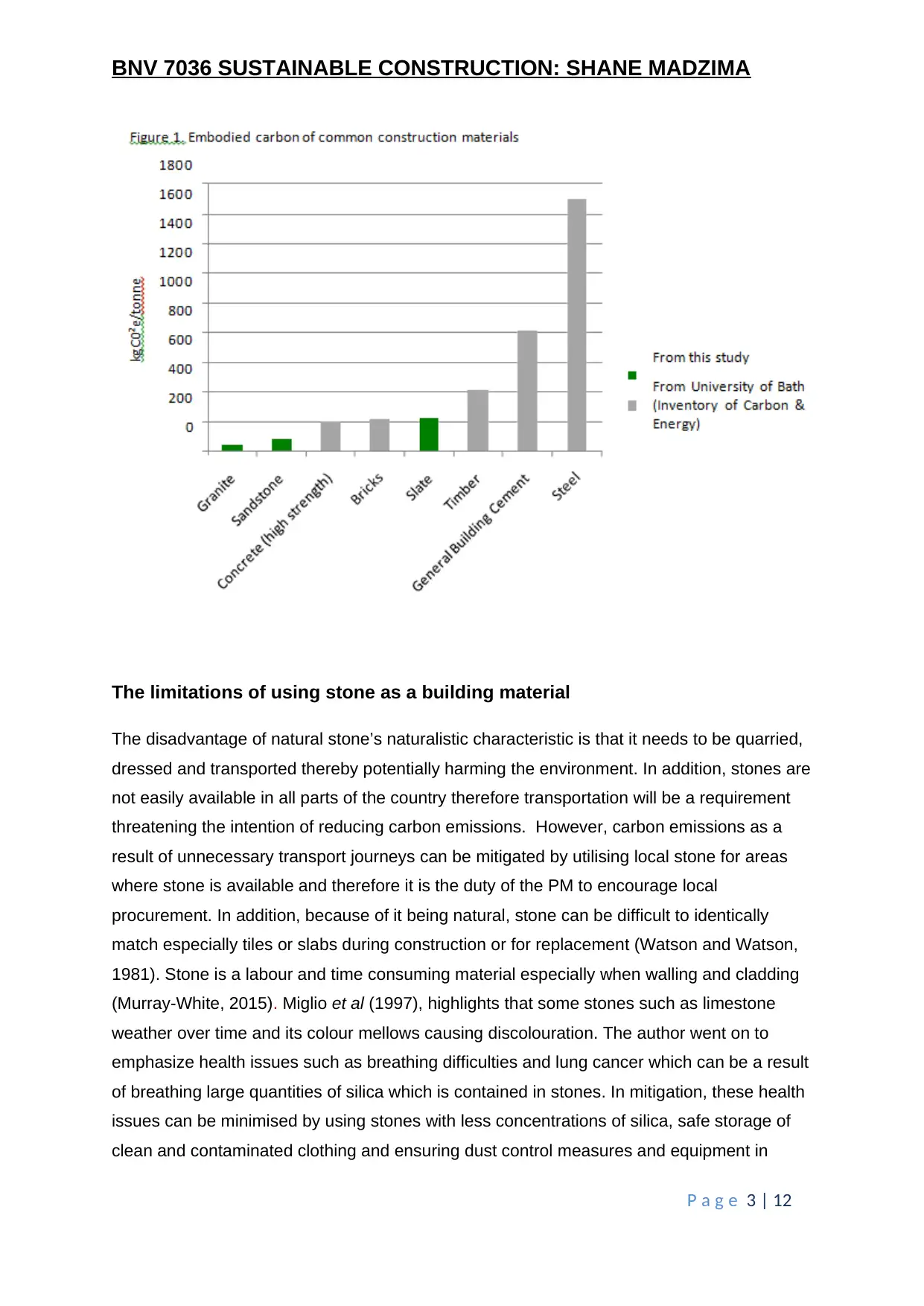
BNV 7036 SUSTAINABLE CONSTRUCTION: SHANE MADZIMA
The limitations of using stone as a building material
The disadvantage of natural stone’s naturalistic characteristic is that it needs to be quarried,
dressed and transported thereby potentially harming the environment. In addition, stones are
not easily available in all parts of the country therefore transportation will be a requirement
threatening the intention of reducing carbon emissions. However, carbon emissions as a
result of unnecessary transport journeys can be mitigated by utilising local stone for areas
where stone is available and therefore it is the duty of the PM to encourage local
procurement. In addition, because of it being natural, stone can be difficult to identically
match especially tiles or slabs during construction or for replacement (Watson and Watson,
1981). Stone is a labour and time consuming material especially when walling and cladding
(Murray-White, 2015). Miglio et al (1997), highlights that some stones such as limestone
weather over time and its colour mellows causing discolouration. The author went on to
emphasize health issues such as breathing difficulties and lung cancer which can be a result
of breathing large quantities of silica which is contained in stones. In mitigation, these health
issues can be minimised by using stones with less concentrations of silica, safe storage of
clean and contaminated clothing and ensuring dust control measures and equipment in
P a g e 3 | 12
The limitations of using stone as a building material
The disadvantage of natural stone’s naturalistic characteristic is that it needs to be quarried,
dressed and transported thereby potentially harming the environment. In addition, stones are
not easily available in all parts of the country therefore transportation will be a requirement
threatening the intention of reducing carbon emissions. However, carbon emissions as a
result of unnecessary transport journeys can be mitigated by utilising local stone for areas
where stone is available and therefore it is the duty of the PM to encourage local
procurement. In addition, because of it being natural, stone can be difficult to identically
match especially tiles or slabs during construction or for replacement (Watson and Watson,
1981). Stone is a labour and time consuming material especially when walling and cladding
(Murray-White, 2015). Miglio et al (1997), highlights that some stones such as limestone
weather over time and its colour mellows causing discolouration. The author went on to
emphasize health issues such as breathing difficulties and lung cancer which can be a result
of breathing large quantities of silica which is contained in stones. In mitigation, these health
issues can be minimised by using stones with less concentrations of silica, safe storage of
clean and contaminated clothing and ensuring dust control measures and equipment in
P a g e 3 | 12
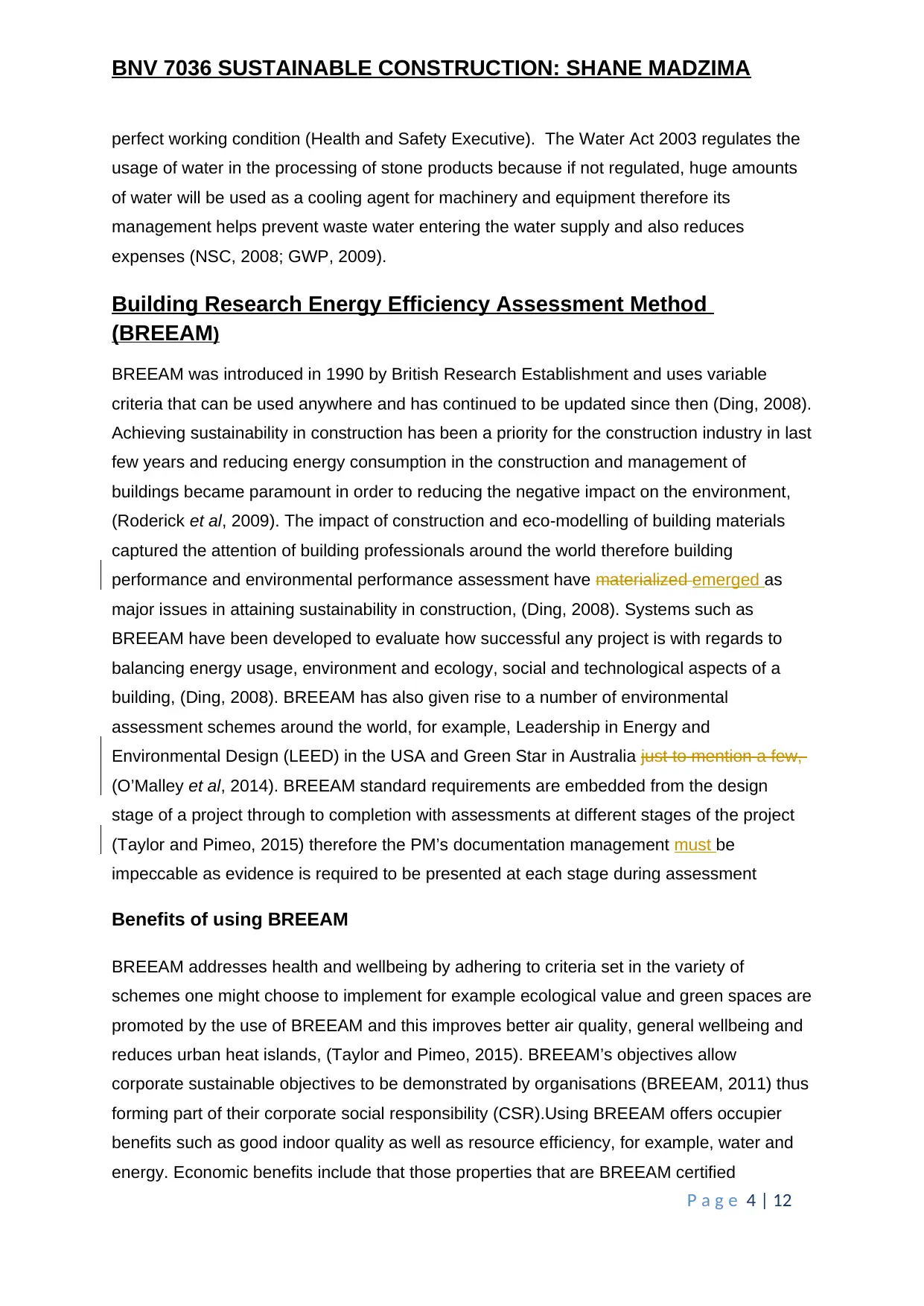
BNV 7036 SUSTAINABLE CONSTRUCTION: SHANE MADZIMA
perfect working condition (Health and Safety Executive). The Water Act 2003 regulates the
usage of water in the processing of stone products because if not regulated, huge amounts
of water will be used as a cooling agent for machinery and equipment therefore its
management helps prevent waste water entering the water supply and also reduces
expenses (NSC, 2008; GWP, 2009).
Building Research Energy Efficiency Assessment Method
(BREEAM)
BREEAM was introduced in 1990 by British Research Establishment and uses variable
criteria that can be used anywhere and has continued to be updated since then (Ding, 2008).
Achieving sustainability in construction has been a priority for the construction industry in last
few years and reducing energy consumption in the construction and management of
buildings became paramount in order to reducing the negative impact on the environment,
(Roderick et al, 2009). The impact of construction and eco-modelling of building materials
captured the attention of building professionals around the world therefore building
performance and environmental performance assessment have materialized emerged as
major issues in attaining sustainability in construction, (Ding, 2008). Systems such as
BREEAM have been developed to evaluate how successful any project is with regards to
balancing energy usage, environment and ecology, social and technological aspects of a
building, (Ding, 2008). BREEAM has also given rise to a number of environmental
assessment schemes around the world, for example, Leadership in Energy and
Environmental Design (LEED) in the USA and Green Star in Australia just to mention a few,
(O’Malley et al, 2014). BREEAM standard requirements are embedded from the design
stage of a project through to completion with assessments at different stages of the project
(Taylor and Pimeo, 2015) therefore the PM’s documentation management must be
impeccable as evidence is required to be presented at each stage during assessment
Benefits of using BREEAM
BREEAM addresses health and wellbeing by adhering to criteria set in the variety of
schemes one might choose to implement for example ecological value and green spaces are
promoted by the use of BREEAM and this improves better air quality, general wellbeing and
reduces urban heat islands, (Taylor and Pimeo, 2015). BREEAM’s objectives allow
corporate sustainable objectives to be demonstrated by organisations (BREEAM, 2011) thus
forming part of their corporate social responsibility (CSR).Using BREEAM offers occupier
benefits such as good indoor quality as well as resource efficiency, for example, water and
energy. Economic benefits include that those properties that are BREEAM certified
P a g e 4 | 12
perfect working condition (Health and Safety Executive). The Water Act 2003 regulates the
usage of water in the processing of stone products because if not regulated, huge amounts
of water will be used as a cooling agent for machinery and equipment therefore its
management helps prevent waste water entering the water supply and also reduces
expenses (NSC, 2008; GWP, 2009).
Building Research Energy Efficiency Assessment Method
(BREEAM)
BREEAM was introduced in 1990 by British Research Establishment and uses variable
criteria that can be used anywhere and has continued to be updated since then (Ding, 2008).
Achieving sustainability in construction has been a priority for the construction industry in last
few years and reducing energy consumption in the construction and management of
buildings became paramount in order to reducing the negative impact on the environment,
(Roderick et al, 2009). The impact of construction and eco-modelling of building materials
captured the attention of building professionals around the world therefore building
performance and environmental performance assessment have materialized emerged as
major issues in attaining sustainability in construction, (Ding, 2008). Systems such as
BREEAM have been developed to evaluate how successful any project is with regards to
balancing energy usage, environment and ecology, social and technological aspects of a
building, (Ding, 2008). BREEAM has also given rise to a number of environmental
assessment schemes around the world, for example, Leadership in Energy and
Environmental Design (LEED) in the USA and Green Star in Australia just to mention a few,
(O’Malley et al, 2014). BREEAM standard requirements are embedded from the design
stage of a project through to completion with assessments at different stages of the project
(Taylor and Pimeo, 2015) therefore the PM’s documentation management must be
impeccable as evidence is required to be presented at each stage during assessment
Benefits of using BREEAM
BREEAM addresses health and wellbeing by adhering to criteria set in the variety of
schemes one might choose to implement for example ecological value and green spaces are
promoted by the use of BREEAM and this improves better air quality, general wellbeing and
reduces urban heat islands, (Taylor and Pimeo, 2015). BREEAM’s objectives allow
corporate sustainable objectives to be demonstrated by organisations (BREEAM, 2011) thus
forming part of their corporate social responsibility (CSR).Using BREEAM offers occupier
benefits such as good indoor quality as well as resource efficiency, for example, water and
energy. Economic benefits include that those properties that are BREEAM certified
P a g e 4 | 12
Secure Best Marks with AI Grader
Need help grading? Try our AI Grader for instant feedback on your assignments.
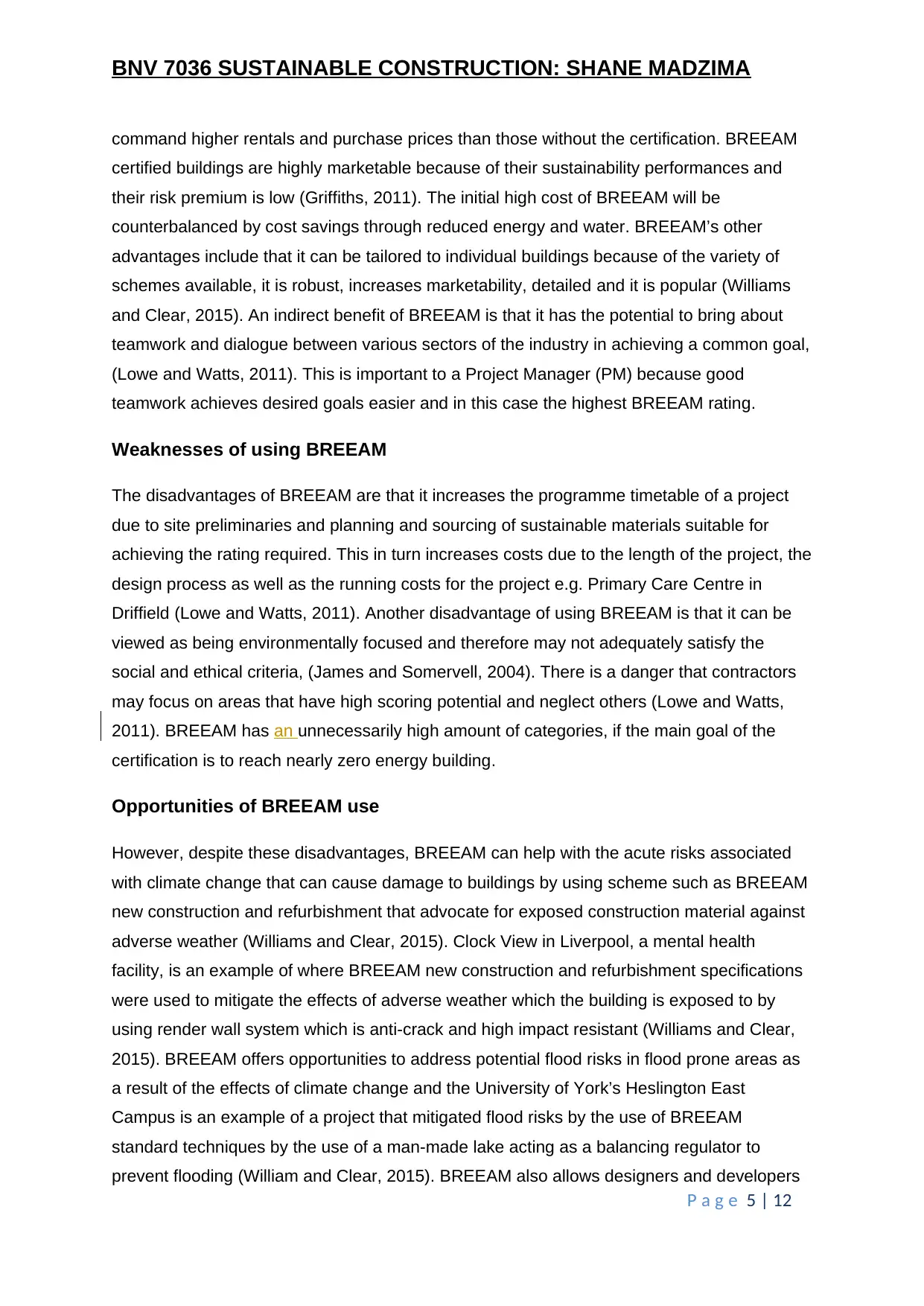
BNV 7036 SUSTAINABLE CONSTRUCTION: SHANE MADZIMA
command higher rentals and purchase prices than those without the certification. BREEAM
certified buildings are highly marketable because of their sustainability performances and
their risk premium is low (Griffiths, 2011). The initial high cost of BREEAM will be
counterbalanced by cost savings through reduced energy and water. BREEAM’s other
advantages include that it can be tailored to individual buildings because of the variety of
schemes available, it is robust, increases marketability, detailed and it is popular (Williams
and Clear, 2015). An indirect benefit of BREEAM is that it has the potential to bring about
teamwork and dialogue between various sectors of the industry in achieving a common goal,
(Lowe and Watts, 2011). This is important to a Project Manager (PM) because good
teamwork achieves desired goals easier and in this case the highest BREEAM rating.
Weaknesses of using BREEAM
The disadvantages of BREEAM are that it increases the programme timetable of a project
due to site preliminaries and planning and sourcing of sustainable materials suitable for
achieving the rating required. This in turn increases costs due to the length of the project, the
design process as well as the running costs for the project e.g. Primary Care Centre in
Driffield (Lowe and Watts, 2011). Another disadvantage of using BREEAM is that it can be
viewed as being environmentally focused and therefore may not adequately satisfy the
social and ethical criteria, (James and Somervell, 2004). There is a danger that contractors
may focus on areas that have high scoring potential and neglect others (Lowe and Watts,
2011). BREEAM has an unnecessarily high amount of categories, if the main goal of the
certification is to reach nearly zero energy building.
Opportunities of BREEAM use
However, despite these disadvantages, BREEAM can help with the acute risks associated
with climate change that can cause damage to buildings by using scheme such as BREEAM
new construction and refurbishment that advocate for exposed construction material against
adverse weather (Williams and Clear, 2015). Clock View in Liverpool, a mental health
facility, is an example of where BREEAM new construction and refurbishment specifications
were used to mitigate the effects of adverse weather which the building is exposed to by
using render wall system which is anti-crack and high impact resistant (Williams and Clear,
2015). BREEAM offers opportunities to address potential flood risks in flood prone areas as
a result of the effects of climate change and the University of York’s Heslington East
Campus is an example of a project that mitigated flood risks by the use of BREEAM
standard techniques by the use of a man-made lake acting as a balancing regulator to
prevent flooding (William and Clear, 2015). BREEAM also allows designers and developers
P a g e 5 | 12
command higher rentals and purchase prices than those without the certification. BREEAM
certified buildings are highly marketable because of their sustainability performances and
their risk premium is low (Griffiths, 2011). The initial high cost of BREEAM will be
counterbalanced by cost savings through reduced energy and water. BREEAM’s other
advantages include that it can be tailored to individual buildings because of the variety of
schemes available, it is robust, increases marketability, detailed and it is popular (Williams
and Clear, 2015). An indirect benefit of BREEAM is that it has the potential to bring about
teamwork and dialogue between various sectors of the industry in achieving a common goal,
(Lowe and Watts, 2011). This is important to a Project Manager (PM) because good
teamwork achieves desired goals easier and in this case the highest BREEAM rating.
Weaknesses of using BREEAM
The disadvantages of BREEAM are that it increases the programme timetable of a project
due to site preliminaries and planning and sourcing of sustainable materials suitable for
achieving the rating required. This in turn increases costs due to the length of the project, the
design process as well as the running costs for the project e.g. Primary Care Centre in
Driffield (Lowe and Watts, 2011). Another disadvantage of using BREEAM is that it can be
viewed as being environmentally focused and therefore may not adequately satisfy the
social and ethical criteria, (James and Somervell, 2004). There is a danger that contractors
may focus on areas that have high scoring potential and neglect others (Lowe and Watts,
2011). BREEAM has an unnecessarily high amount of categories, if the main goal of the
certification is to reach nearly zero energy building.
Opportunities of BREEAM use
However, despite these disadvantages, BREEAM can help with the acute risks associated
with climate change that can cause damage to buildings by using scheme such as BREEAM
new construction and refurbishment that advocate for exposed construction material against
adverse weather (Williams and Clear, 2015). Clock View in Liverpool, a mental health
facility, is an example of where BREEAM new construction and refurbishment specifications
were used to mitigate the effects of adverse weather which the building is exposed to by
using render wall system which is anti-crack and high impact resistant (Williams and Clear,
2015). BREEAM offers opportunities to address potential flood risks in flood prone areas as
a result of the effects of climate change and the University of York’s Heslington East
Campus is an example of a project that mitigated flood risks by the use of BREEAM
standard techniques by the use of a man-made lake acting as a balancing regulator to
prevent flooding (William and Clear, 2015). BREEAM also allows designers and developers
P a g e 5 | 12
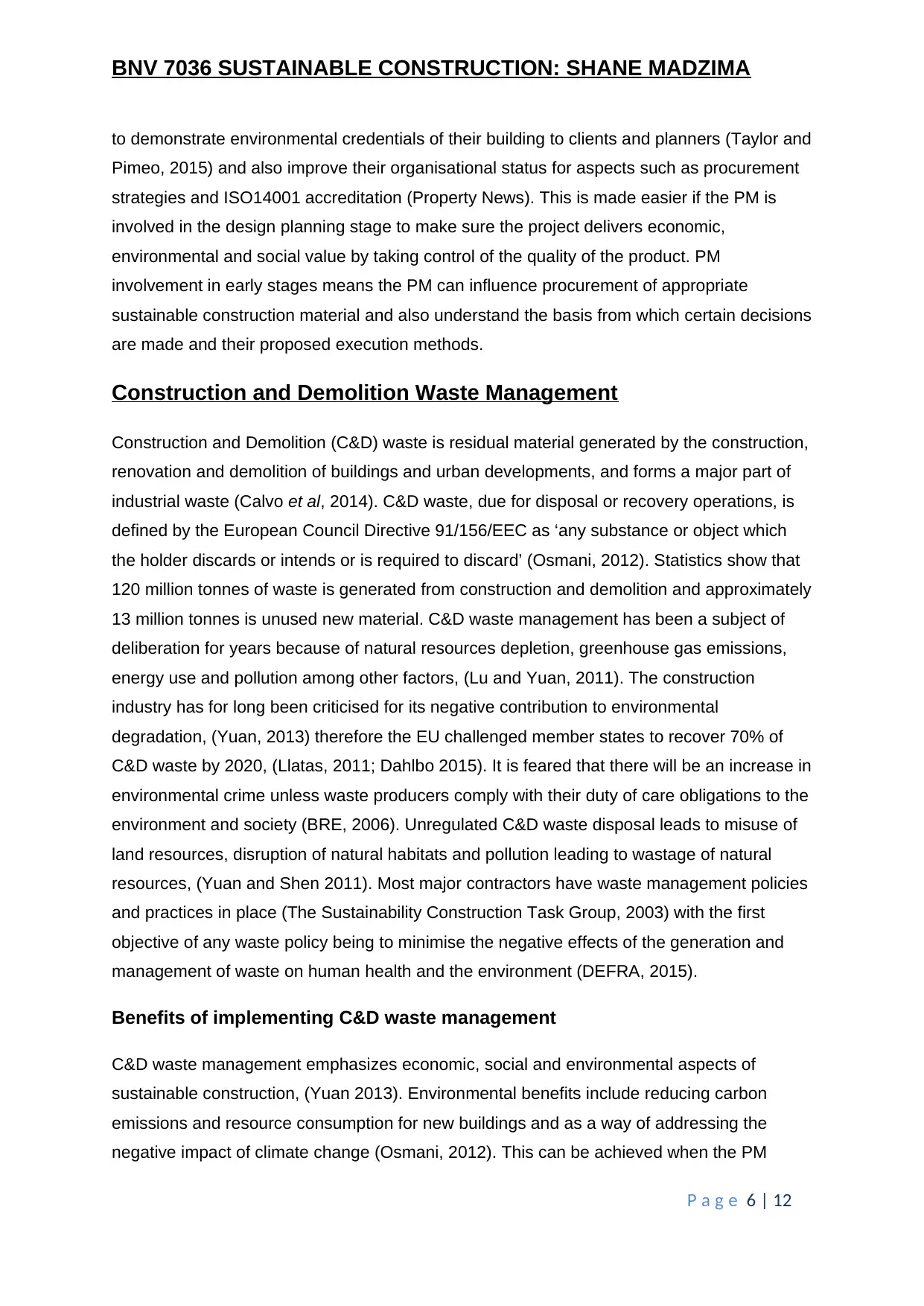
BNV 7036 SUSTAINABLE CONSTRUCTION: SHANE MADZIMA
to demonstrate environmental credentials of their building to clients and planners (Taylor and
Pimeo, 2015) and also improve their organisational status for aspects such as procurement
strategies and ISO14001 accreditation (Property News). This is made easier if the PM is
involved in the design planning stage to make sure the project delivers economic,
environmental and social value by taking control of the quality of the product. PM
involvement in early stages means the PM can influence procurement of appropriate
sustainable construction material and also understand the basis from which certain decisions
are made and their proposed execution methods.
Construction and Demolition Waste Management
Construction and Demolition (C&D) waste is residual material generated by the construction,
renovation and demolition of buildings and urban developments, and forms a major part of
industrial waste (Calvo et al, 2014). C&D waste, due for disposal or recovery operations, is
defined by the European Council Directive 91/156/EEC as ‘any substance or object which
the holder discards or intends or is required to discard’ (Osmani, 2012). Statistics show that
120 million tonnes of waste is generated from construction and demolition and approximately
13 million tonnes is unused new material. C&D waste management has been a subject of
deliberation for years because of natural resources depletion, greenhouse gas emissions,
energy use and pollution among other factors, (Lu and Yuan, 2011). The construction
industry has for long been criticised for its negative contribution to environmental
degradation, (Yuan, 2013) therefore the EU challenged member states to recover 70% of
C&D waste by 2020, (Llatas, 2011; Dahlbo 2015). It is feared that there will be an increase in
environmental crime unless waste producers comply with their duty of care obligations to the
environment and society (BRE, 2006). Unregulated C&D waste disposal leads to misuse of
land resources, disruption of natural habitats and pollution leading to wastage of natural
resources, (Yuan and Shen 2011). Most major contractors have waste management policies
and practices in place (The Sustainability Construction Task Group, 2003) with the first
objective of any waste policy being to minimise the negative effects of the generation and
management of waste on human health and the environment (DEFRA, 2015).
Benefits of implementing C&D waste management
C&D waste management emphasizes economic, social and environmental aspects of
sustainable construction, (Yuan 2013). Environmental benefits include reducing carbon
emissions and resource consumption for new buildings and as a way of addressing the
negative impact of climate change (Osmani, 2012). This can be achieved when the PM
P a g e 6 | 12
to demonstrate environmental credentials of their building to clients and planners (Taylor and
Pimeo, 2015) and also improve their organisational status for aspects such as procurement
strategies and ISO14001 accreditation (Property News). This is made easier if the PM is
involved in the design planning stage to make sure the project delivers economic,
environmental and social value by taking control of the quality of the product. PM
involvement in early stages means the PM can influence procurement of appropriate
sustainable construction material and also understand the basis from which certain decisions
are made and their proposed execution methods.
Construction and Demolition Waste Management
Construction and Demolition (C&D) waste is residual material generated by the construction,
renovation and demolition of buildings and urban developments, and forms a major part of
industrial waste (Calvo et al, 2014). C&D waste, due for disposal or recovery operations, is
defined by the European Council Directive 91/156/EEC as ‘any substance or object which
the holder discards or intends or is required to discard’ (Osmani, 2012). Statistics show that
120 million tonnes of waste is generated from construction and demolition and approximately
13 million tonnes is unused new material. C&D waste management has been a subject of
deliberation for years because of natural resources depletion, greenhouse gas emissions,
energy use and pollution among other factors, (Lu and Yuan, 2011). The construction
industry has for long been criticised for its negative contribution to environmental
degradation, (Yuan, 2013) therefore the EU challenged member states to recover 70% of
C&D waste by 2020, (Llatas, 2011; Dahlbo 2015). It is feared that there will be an increase in
environmental crime unless waste producers comply with their duty of care obligations to the
environment and society (BRE, 2006). Unregulated C&D waste disposal leads to misuse of
land resources, disruption of natural habitats and pollution leading to wastage of natural
resources, (Yuan and Shen 2011). Most major contractors have waste management policies
and practices in place (The Sustainability Construction Task Group, 2003) with the first
objective of any waste policy being to minimise the negative effects of the generation and
management of waste on human health and the environment (DEFRA, 2015).
Benefits of implementing C&D waste management
C&D waste management emphasizes economic, social and environmental aspects of
sustainable construction, (Yuan 2013). Environmental benefits include reducing carbon
emissions and resource consumption for new buildings and as a way of addressing the
negative impact of climate change (Osmani, 2012). This can be achieved when the PM
P a g e 6 | 12
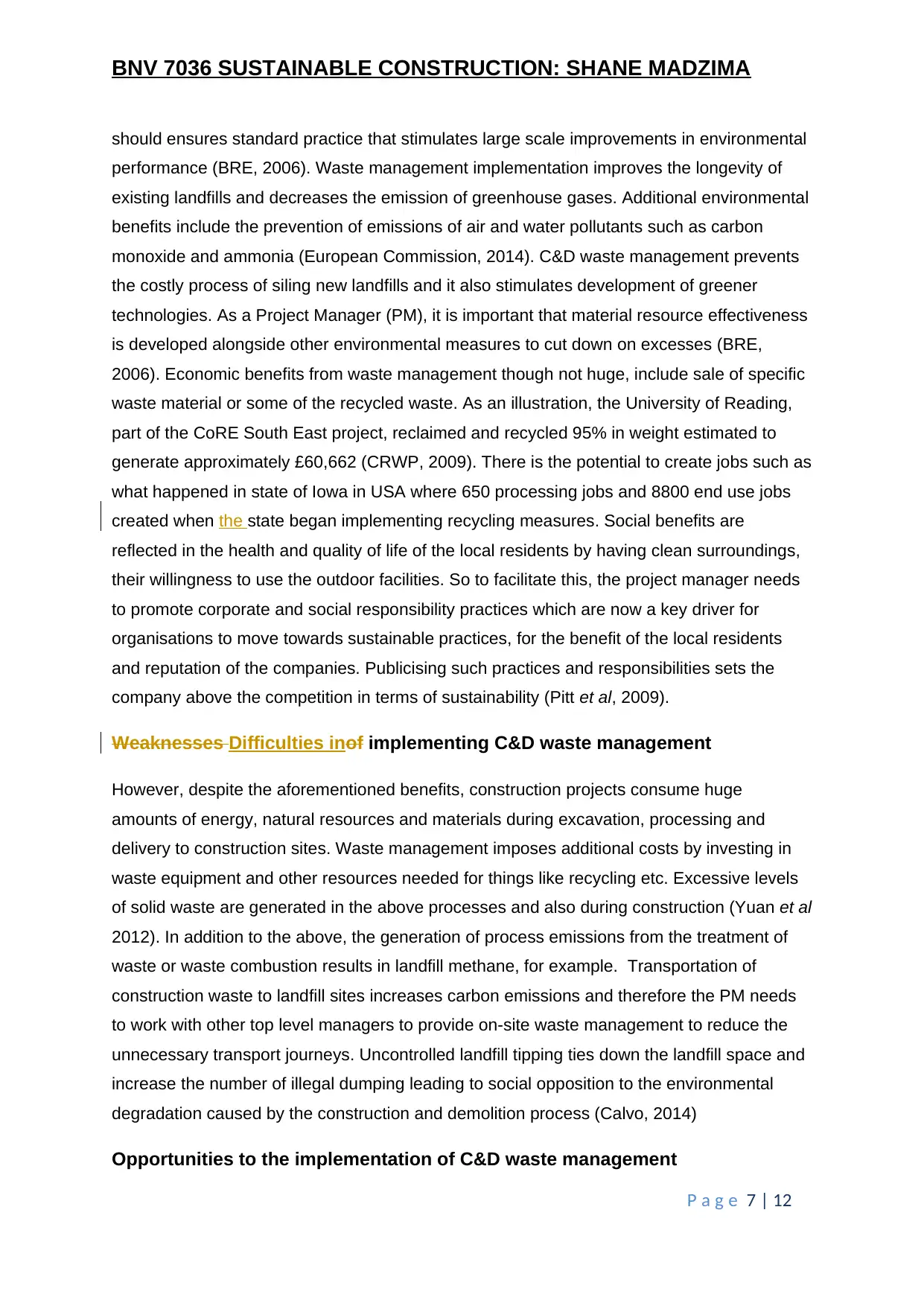
BNV 7036 SUSTAINABLE CONSTRUCTION: SHANE MADZIMA
should ensures standard practice that stimulates large scale improvements in environmental
performance (BRE, 2006). Waste management implementation improves the longevity of
existing landfills and decreases the emission of greenhouse gases. Additional environmental
benefits include the prevention of emissions of air and water pollutants such as carbon
monoxide and ammonia (European Commission, 2014). C&D waste management prevents
the costly process of siling new landfills and it also stimulates development of greener
technologies. As a Project Manager (PM), it is important that material resource effectiveness
is developed alongside other environmental measures to cut down on excesses (BRE,
2006). Economic benefits from waste management though not huge, include sale of specific
waste material or some of the recycled waste. As an illustration, the University of Reading,
part of the CoRE South East project, reclaimed and recycled 95% in weight estimated to
generate approximately £60,662 (CRWP, 2009). There is the potential to create jobs such as
what happened in state of Iowa in USA where 650 processing jobs and 8800 end use jobs
created when the state began implementing recycling measures. Social benefits are
reflected in the health and quality of life of the local residents by having clean surroundings,
their willingness to use the outdoor facilities. So to facilitate this, the project manager needs
to promote corporate and social responsibility practices which are now a key driver for
organisations to move towards sustainable practices, for the benefit of the local residents
and reputation of the companies. Publicising such practices and responsibilities sets the
company above the competition in terms of sustainability (Pitt et al, 2009).
Weaknesses Difficulties inof implementing C&D waste management
However, despite the aforementioned benefits, construction projects consume huge
amounts of energy, natural resources and materials during excavation, processing and
delivery to construction sites. Waste management imposes additional costs by investing in
waste equipment and other resources needed for things like recycling etc. Excessive levels
of solid waste are generated in the above processes and also during construction (Yuan et al
2012). In addition to the above, the generation of process emissions from the treatment of
waste or waste combustion results in landfill methane, for example. Transportation of
construction waste to landfill sites increases carbon emissions and therefore the PM needs
to work with other top level managers to provide on-site waste management to reduce the
unnecessary transport journeys. Uncontrolled landfill tipping ties down the landfill space and
increase the number of illegal dumping leading to social opposition to the environmental
degradation caused by the construction and demolition process (Calvo, 2014)
Opportunities to the implementation of C&D waste management
P a g e 7 | 12
should ensures standard practice that stimulates large scale improvements in environmental
performance (BRE, 2006). Waste management implementation improves the longevity of
existing landfills and decreases the emission of greenhouse gases. Additional environmental
benefits include the prevention of emissions of air and water pollutants such as carbon
monoxide and ammonia (European Commission, 2014). C&D waste management prevents
the costly process of siling new landfills and it also stimulates development of greener
technologies. As a Project Manager (PM), it is important that material resource effectiveness
is developed alongside other environmental measures to cut down on excesses (BRE,
2006). Economic benefits from waste management though not huge, include sale of specific
waste material or some of the recycled waste. As an illustration, the University of Reading,
part of the CoRE South East project, reclaimed and recycled 95% in weight estimated to
generate approximately £60,662 (CRWP, 2009). There is the potential to create jobs such as
what happened in state of Iowa in USA where 650 processing jobs and 8800 end use jobs
created when the state began implementing recycling measures. Social benefits are
reflected in the health and quality of life of the local residents by having clean surroundings,
their willingness to use the outdoor facilities. So to facilitate this, the project manager needs
to promote corporate and social responsibility practices which are now a key driver for
organisations to move towards sustainable practices, for the benefit of the local residents
and reputation of the companies. Publicising such practices and responsibilities sets the
company above the competition in terms of sustainability (Pitt et al, 2009).
Weaknesses Difficulties inof implementing C&D waste management
However, despite the aforementioned benefits, construction projects consume huge
amounts of energy, natural resources and materials during excavation, processing and
delivery to construction sites. Waste management imposes additional costs by investing in
waste equipment and other resources needed for things like recycling etc. Excessive levels
of solid waste are generated in the above processes and also during construction (Yuan et al
2012). In addition to the above, the generation of process emissions from the treatment of
waste or waste combustion results in landfill methane, for example. Transportation of
construction waste to landfill sites increases carbon emissions and therefore the PM needs
to work with other top level managers to provide on-site waste management to reduce the
unnecessary transport journeys. Uncontrolled landfill tipping ties down the landfill space and
increase the number of illegal dumping leading to social opposition to the environmental
degradation caused by the construction and demolition process (Calvo, 2014)
Opportunities to the implementation of C&D waste management
P a g e 7 | 12
Paraphrase This Document
Need a fresh take? Get an instant paraphrase of this document with our AI Paraphraser
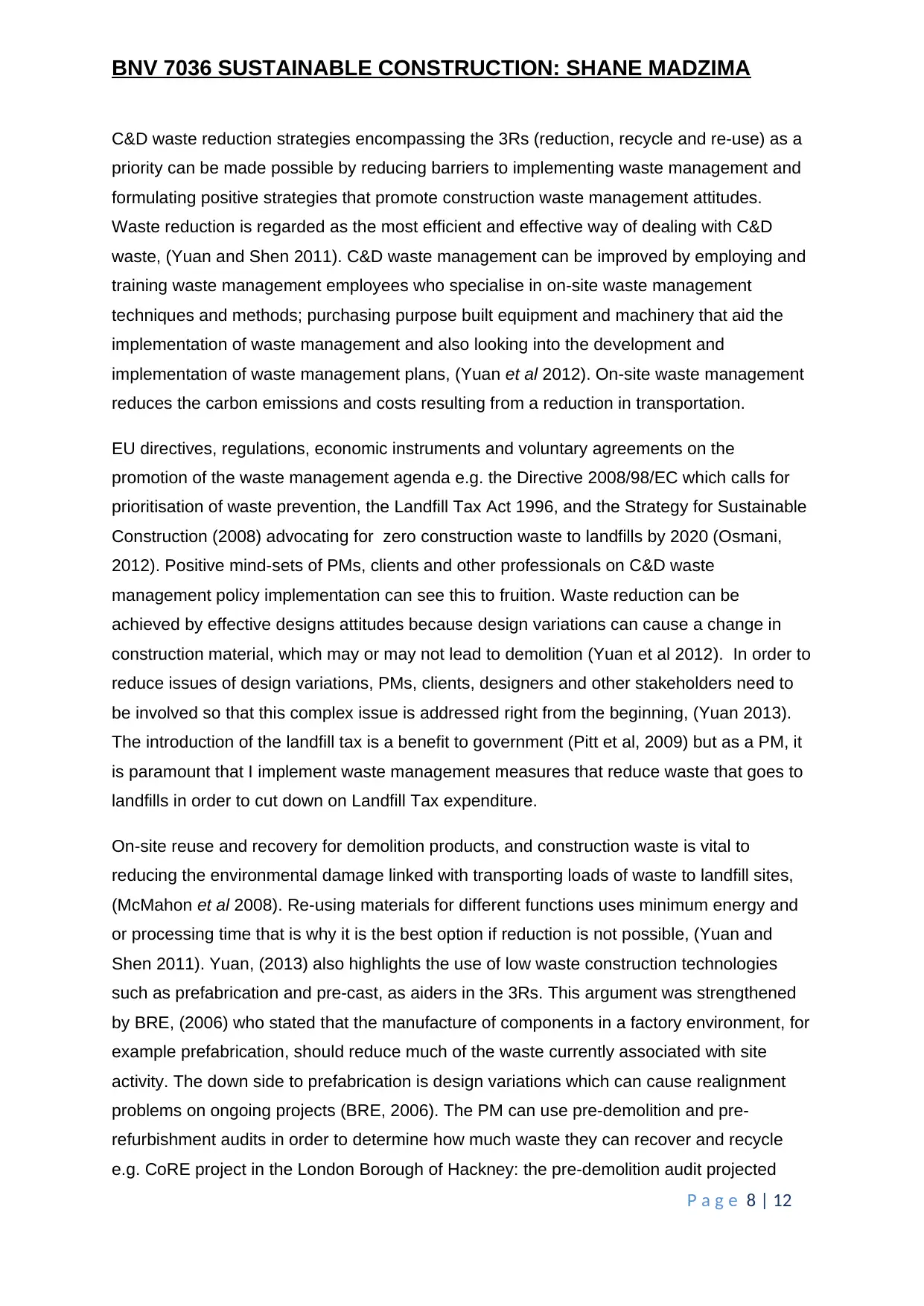
BNV 7036 SUSTAINABLE CONSTRUCTION: SHANE MADZIMA
C&D waste reduction strategies encompassing the 3Rs (reduction, recycle and re-use) as a
priority can be made possible by reducing barriers to implementing waste management and
formulating positive strategies that promote construction waste management attitudes.
Waste reduction is regarded as the most efficient and effective way of dealing with C&D
waste, (Yuan and Shen 2011). C&D waste management can be improved by employing and
training waste management employees who specialise in on-site waste management
techniques and methods; purchasing purpose built equipment and machinery that aid the
implementation of waste management and also looking into the development and
implementation of waste management plans, (Yuan et al 2012). On-site waste management
reduces the carbon emissions and costs resulting from a reduction in transportation.
EU directives, regulations, economic instruments and voluntary agreements on the
promotion of the waste management agenda e.g. the Directive 2008/98/EC which calls for
prioritisation of waste prevention, the Landfill Tax Act 1996, and the Strategy for Sustainable
Construction (2008) advocating for zero construction waste to landfills by 2020 (Osmani,
2012). Positive mind-sets of PMs, clients and other professionals on C&D waste
management policy implementation can see this to fruition. Waste reduction can be
achieved by effective designs attitudes because design variations can cause a change in
construction material, which may or may not lead to demolition (Yuan et al 2012). In order to
reduce issues of design variations, PMs, clients, designers and other stakeholders need to
be involved so that this complex issue is addressed right from the beginning, (Yuan 2013).
The introduction of the landfill tax is a benefit to government (Pitt et al, 2009) but as a PM, it
is paramount that I implement waste management measures that reduce waste that goes to
landfills in order to cut down on Landfill Tax expenditure.
On-site reuse and recovery for demolition products, and construction waste is vital to
reducing the environmental damage linked with transporting loads of waste to landfill sites,
(McMahon et al 2008). Re-using materials for different functions uses minimum energy and
or processing time that is why it is the best option if reduction is not possible, (Yuan and
Shen 2011). Yuan, (2013) also highlights the use of low waste construction technologies
such as prefabrication and pre-cast, as aiders in the 3Rs. This argument was strengthened
by BRE, (2006) who stated that the manufacture of components in a factory environment, for
example prefabrication, should reduce much of the waste currently associated with site
activity. The down side to prefabrication is design variations which can cause realignment
problems on ongoing projects (BRE, 2006). The PM can use pre-demolition and pre-
refurbishment audits in order to determine how much waste they can recover and recycle
e.g. CoRE project in the London Borough of Hackney: the pre-demolition audit projected
P a g e 8 | 12
C&D waste reduction strategies encompassing the 3Rs (reduction, recycle and re-use) as a
priority can be made possible by reducing barriers to implementing waste management and
formulating positive strategies that promote construction waste management attitudes.
Waste reduction is regarded as the most efficient and effective way of dealing with C&D
waste, (Yuan and Shen 2011). C&D waste management can be improved by employing and
training waste management employees who specialise in on-site waste management
techniques and methods; purchasing purpose built equipment and machinery that aid the
implementation of waste management and also looking into the development and
implementation of waste management plans, (Yuan et al 2012). On-site waste management
reduces the carbon emissions and costs resulting from a reduction in transportation.
EU directives, regulations, economic instruments and voluntary agreements on the
promotion of the waste management agenda e.g. the Directive 2008/98/EC which calls for
prioritisation of waste prevention, the Landfill Tax Act 1996, and the Strategy for Sustainable
Construction (2008) advocating for zero construction waste to landfills by 2020 (Osmani,
2012). Positive mind-sets of PMs, clients and other professionals on C&D waste
management policy implementation can see this to fruition. Waste reduction can be
achieved by effective designs attitudes because design variations can cause a change in
construction material, which may or may not lead to demolition (Yuan et al 2012). In order to
reduce issues of design variations, PMs, clients, designers and other stakeholders need to
be involved so that this complex issue is addressed right from the beginning, (Yuan 2013).
The introduction of the landfill tax is a benefit to government (Pitt et al, 2009) but as a PM, it
is paramount that I implement waste management measures that reduce waste that goes to
landfills in order to cut down on Landfill Tax expenditure.
On-site reuse and recovery for demolition products, and construction waste is vital to
reducing the environmental damage linked with transporting loads of waste to landfill sites,
(McMahon et al 2008). Re-using materials for different functions uses minimum energy and
or processing time that is why it is the best option if reduction is not possible, (Yuan and
Shen 2011). Yuan, (2013) also highlights the use of low waste construction technologies
such as prefabrication and pre-cast, as aiders in the 3Rs. This argument was strengthened
by BRE, (2006) who stated that the manufacture of components in a factory environment, for
example prefabrication, should reduce much of the waste currently associated with site
activity. The down side to prefabrication is design variations which can cause realignment
problems on ongoing projects (BRE, 2006). The PM can use pre-demolition and pre-
refurbishment audits in order to determine how much waste they can recover and recycle
e.g. CoRE project in the London Borough of Hackney: the pre-demolition audit projected
P a g e 8 | 12
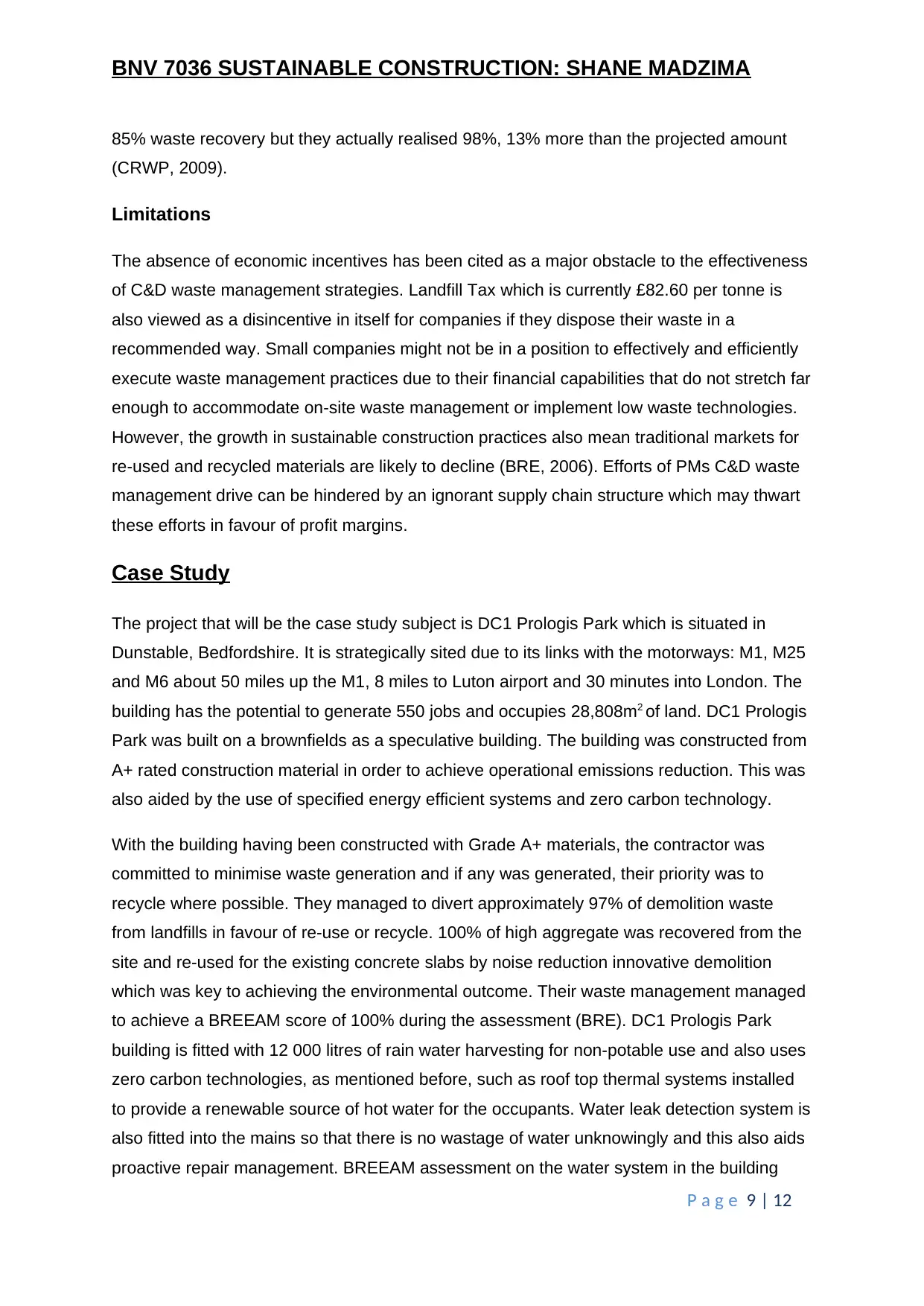
BNV 7036 SUSTAINABLE CONSTRUCTION: SHANE MADZIMA
85% waste recovery but they actually realised 98%, 13% more than the projected amount
(CRWP, 2009).
Limitations
The absence of economic incentives has been cited as a major obstacle to the effectiveness
of C&D waste management strategies. Landfill Tax which is currently £82.60 per tonne is
also viewed as a disincentive in itself for companies if they dispose their waste in a
recommended way. Small companies might not be in a position to effectively and efficiently
execute waste management practices due to their financial capabilities that do not stretch far
enough to accommodate on-site waste management or implement low waste technologies.
However, the growth in sustainable construction practices also mean traditional markets for
re-used and recycled materials are likely to decline (BRE, 2006). Efforts of PMs C&D waste
management drive can be hindered by an ignorant supply chain structure which may thwart
these efforts in favour of profit margins.
Case Study
The project that will be the case study subject is DC1 Prologis Park which is situated in
Dunstable, Bedfordshire. It is strategically sited due to its links with the motorways: M1, M25
and M6 about 50 miles up the M1, 8 miles to Luton airport and 30 minutes into London. The
building has the potential to generate 550 jobs and occupies 28,808m2 of land. DC1 Prologis
Park was built on a brownfields as a speculative building. The building was constructed from
A+ rated construction material in order to achieve operational emissions reduction. This was
also aided by the use of specified energy efficient systems and zero carbon technology.
With the building having been constructed with Grade A+ materials, the contractor was
committed to minimise waste generation and if any was generated, their priority was to
recycle where possible. They managed to divert approximately 97% of demolition waste
from landfills in favour of re-use or recycle. 100% of high aggregate was recovered from the
site and re-used for the existing concrete slabs by noise reduction innovative demolition
which was key to achieving the environmental outcome. Their waste management managed
to achieve a BREEAM score of 100% during the assessment (BRE). DC1 Prologis Park
building is fitted with 12 000 litres of rain water harvesting for non-potable use and also uses
zero carbon technologies, as mentioned before, such as roof top thermal systems installed
to provide a renewable source of hot water for the occupants. Water leak detection system is
also fitted into the mains so that there is no wastage of water unknowingly and this also aids
proactive repair management. BREEAM assessment on the water system in the building
P a g e 9 | 12
85% waste recovery but they actually realised 98%, 13% more than the projected amount
(CRWP, 2009).
Limitations
The absence of economic incentives has been cited as a major obstacle to the effectiveness
of C&D waste management strategies. Landfill Tax which is currently £82.60 per tonne is
also viewed as a disincentive in itself for companies if they dispose their waste in a
recommended way. Small companies might not be in a position to effectively and efficiently
execute waste management practices due to their financial capabilities that do not stretch far
enough to accommodate on-site waste management or implement low waste technologies.
However, the growth in sustainable construction practices also mean traditional markets for
re-used and recycled materials are likely to decline (BRE, 2006). Efforts of PMs C&D waste
management drive can be hindered by an ignorant supply chain structure which may thwart
these efforts in favour of profit margins.
Case Study
The project that will be the case study subject is DC1 Prologis Park which is situated in
Dunstable, Bedfordshire. It is strategically sited due to its links with the motorways: M1, M25
and M6 about 50 miles up the M1, 8 miles to Luton airport and 30 minutes into London. The
building has the potential to generate 550 jobs and occupies 28,808m2 of land. DC1 Prologis
Park was built on a brownfields as a speculative building. The building was constructed from
A+ rated construction material in order to achieve operational emissions reduction. This was
also aided by the use of specified energy efficient systems and zero carbon technology.
With the building having been constructed with Grade A+ materials, the contractor was
committed to minimise waste generation and if any was generated, their priority was to
recycle where possible. They managed to divert approximately 97% of demolition waste
from landfills in favour of re-use or recycle. 100% of high aggregate was recovered from the
site and re-used for the existing concrete slabs by noise reduction innovative demolition
which was key to achieving the environmental outcome. Their waste management managed
to achieve a BREEAM score of 100% during the assessment (BRE). DC1 Prologis Park
building is fitted with 12 000 litres of rain water harvesting for non-potable use and also uses
zero carbon technologies, as mentioned before, such as roof top thermal systems installed
to provide a renewable source of hot water for the occupants. Water leak detection system is
also fitted into the mains so that there is no wastage of water unknowingly and this also aids
proactive repair management. BREEAM assessment on the water system in the building
P a g e 9 | 12
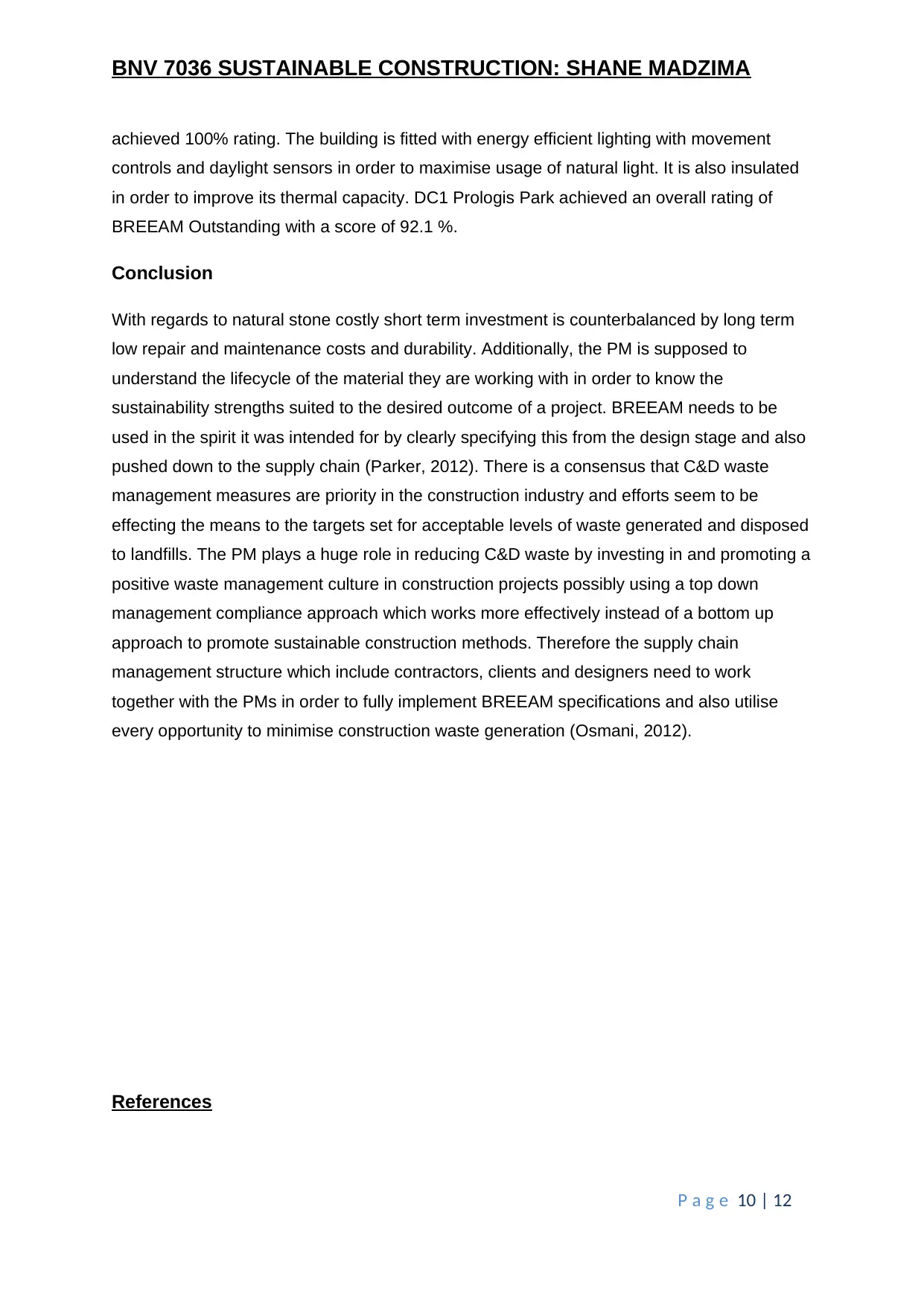
BNV 7036 SUSTAINABLE CONSTRUCTION: SHANE MADZIMA
achieved 100% rating. The building is fitted with energy efficient lighting with movement
controls and daylight sensors in order to maximise usage of natural light. It is also insulated
in order to improve its thermal capacity. DC1 Prologis Park achieved an overall rating of
BREEAM Outstanding with a score of 92.1 %.
Conclusion
With regards to natural stone costly short term investment is counterbalanced by long term
low repair and maintenance costs and durability. Additionally, the PM is supposed to
understand the lifecycle of the material they are working with in order to know the
sustainability strengths suited to the desired outcome of a project. BREEAM needs to be
used in the spirit it was intended for by clearly specifying this from the design stage and also
pushed down to the supply chain (Parker, 2012). There is a consensus that C&D waste
management measures are priority in the construction industry and efforts seem to be
effecting the means to the targets set for acceptable levels of waste generated and disposed
to landfills. The PM plays a huge role in reducing C&D waste by investing in and promoting a
positive waste management culture in construction projects possibly using a top down
management compliance approach which works more effectively instead of a bottom up
approach to promote sustainable construction methods. Therefore the supply chain
management structure which include contractors, clients and designers need to work
together with the PMs in order to fully implement BREEAM specifications and also utilise
every opportunity to minimise construction waste generation (Osmani, 2012).
References
P a g e 10 | 12
achieved 100% rating. The building is fitted with energy efficient lighting with movement
controls and daylight sensors in order to maximise usage of natural light. It is also insulated
in order to improve its thermal capacity. DC1 Prologis Park achieved an overall rating of
BREEAM Outstanding with a score of 92.1 %.
Conclusion
With regards to natural stone costly short term investment is counterbalanced by long term
low repair and maintenance costs and durability. Additionally, the PM is supposed to
understand the lifecycle of the material they are working with in order to know the
sustainability strengths suited to the desired outcome of a project. BREEAM needs to be
used in the spirit it was intended for by clearly specifying this from the design stage and also
pushed down to the supply chain (Parker, 2012). There is a consensus that C&D waste
management measures are priority in the construction industry and efforts seem to be
effecting the means to the targets set for acceptable levels of waste generated and disposed
to landfills. The PM plays a huge role in reducing C&D waste by investing in and promoting a
positive waste management culture in construction projects possibly using a top down
management compliance approach which works more effectively instead of a bottom up
approach to promote sustainable construction methods. Therefore the supply chain
management structure which include contractors, clients and designers need to work
together with the PMs in order to fully implement BREEAM specifications and also utilise
every opportunity to minimise construction waste generation (Osmani, 2012).
References
P a g e 10 | 12
Secure Best Marks with AI Grader
Need help grading? Try our AI Grader for instant feedback on your assignments.
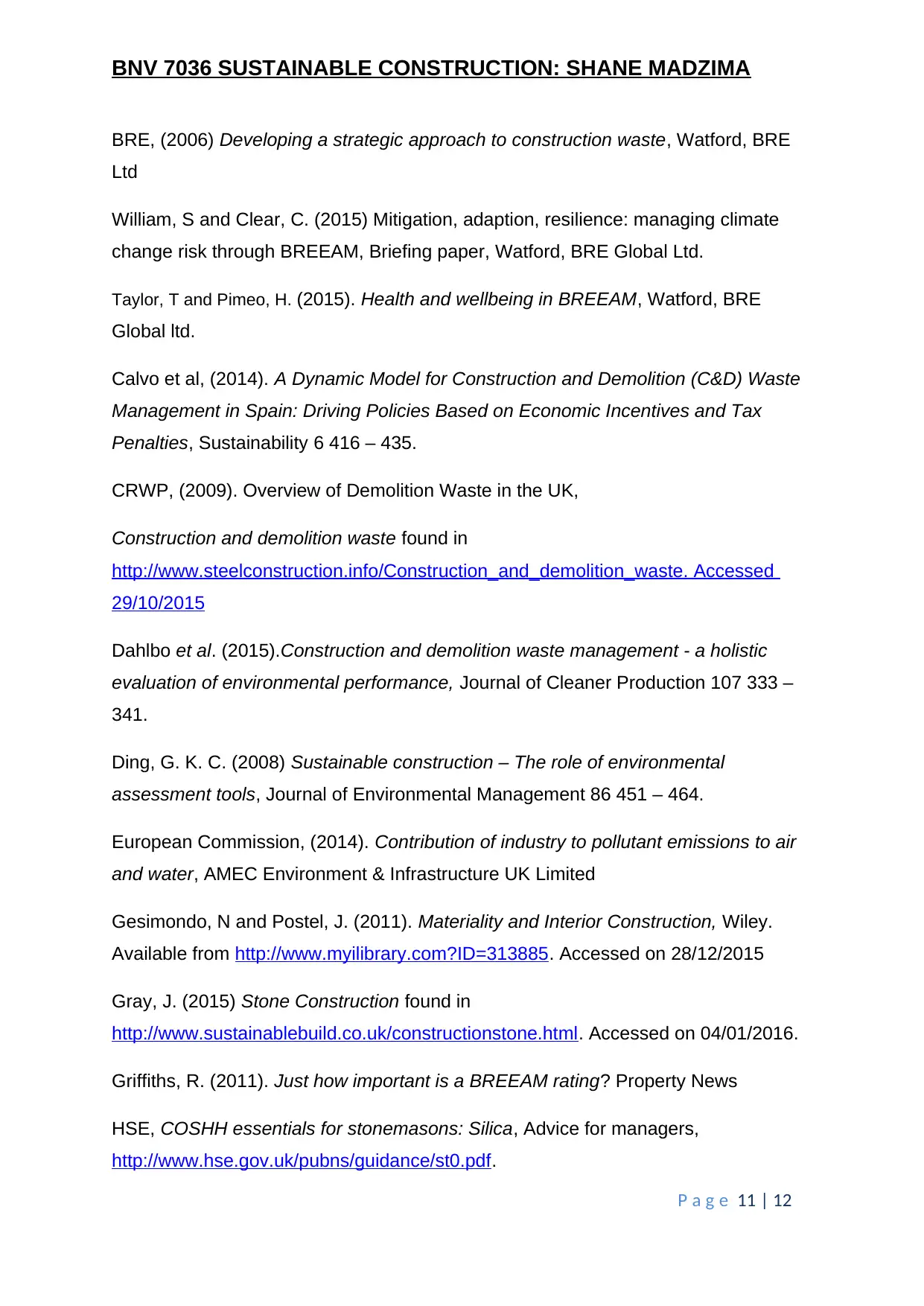
BNV 7036 SUSTAINABLE CONSTRUCTION: SHANE MADZIMA
BRE, (2006) Developing a strategic approach to construction waste, Watford, BRE
Ltd
William, S and Clear, C. (2015) Mitigation, adaption, resilience: managing climate
change risk through BREEAM, Briefing paper, Watford, BRE Global Ltd.
Taylor, T and Pimeo, H. (2015). Health and wellbeing in BREEAM, Watford, BRE
Global ltd.
Calvo et al, (2014). A Dynamic Model for Construction and Demolition (C&D) Waste
Management in Spain: Driving Policies Based on Economic Incentives and Tax
Penalties, Sustainability 6 416 – 435.
CRWP, (2009). Overview of Demolition Waste in the UK,
Construction and demolition waste found in
http://www.steelconstruction.info/Construction_and_demolition_waste. Accessed
29/10/2015
Dahlbo et al. (2015).Construction and demolition waste management - a holistic
evaluation of environmental performance, Journal of Cleaner Production 107 333 –
341.
Ding, G. K. C. (2008) Sustainable construction – The role of environmental
assessment tools, Journal of Environmental Management 86 451 – 464.
European Commission, (2014). Contribution of industry to pollutant emissions to air
and water, AMEC Environment & Infrastructure UK Limited
Gesimondo, N and Postel, J. (2011). Materiality and Interior Construction, Wiley.
Available from http://www.myilibrary.com?ID=313885. Accessed on 28/12/2015
Gray, J. (2015) Stone Construction found in
http://www.sustainablebuild.co.uk/constructionstone.html. Accessed on 04/01/2016.
Griffiths, R. (2011). Just how important is a BREEAM rating? Property News
HSE, COSHH essentials for stonemasons: Silica, Advice for managers,
http://www.hse.gov.uk/pubns/guidance/st0.pdf.
P a g e 11 | 12
BRE, (2006) Developing a strategic approach to construction waste, Watford, BRE
Ltd
William, S and Clear, C. (2015) Mitigation, adaption, resilience: managing climate
change risk through BREEAM, Briefing paper, Watford, BRE Global Ltd.
Taylor, T and Pimeo, H. (2015). Health and wellbeing in BREEAM, Watford, BRE
Global ltd.
Calvo et al, (2014). A Dynamic Model for Construction and Demolition (C&D) Waste
Management in Spain: Driving Policies Based on Economic Incentives and Tax
Penalties, Sustainability 6 416 – 435.
CRWP, (2009). Overview of Demolition Waste in the UK,
Construction and demolition waste found in
http://www.steelconstruction.info/Construction_and_demolition_waste. Accessed
29/10/2015
Dahlbo et al. (2015).Construction and demolition waste management - a holistic
evaluation of environmental performance, Journal of Cleaner Production 107 333 –
341.
Ding, G. K. C. (2008) Sustainable construction – The role of environmental
assessment tools, Journal of Environmental Management 86 451 – 464.
European Commission, (2014). Contribution of industry to pollutant emissions to air
and water, AMEC Environment & Infrastructure UK Limited
Gesimondo, N and Postel, J. (2011). Materiality and Interior Construction, Wiley.
Available from http://www.myilibrary.com?ID=313885. Accessed on 28/12/2015
Gray, J. (2015) Stone Construction found in
http://www.sustainablebuild.co.uk/constructionstone.html. Accessed on 04/01/2016.
Griffiths, R. (2011). Just how important is a BREEAM rating? Property News
HSE, COSHH essentials for stonemasons: Silica, Advice for managers,
http://www.hse.gov.uk/pubns/guidance/st0.pdf.
P a g e 11 | 12
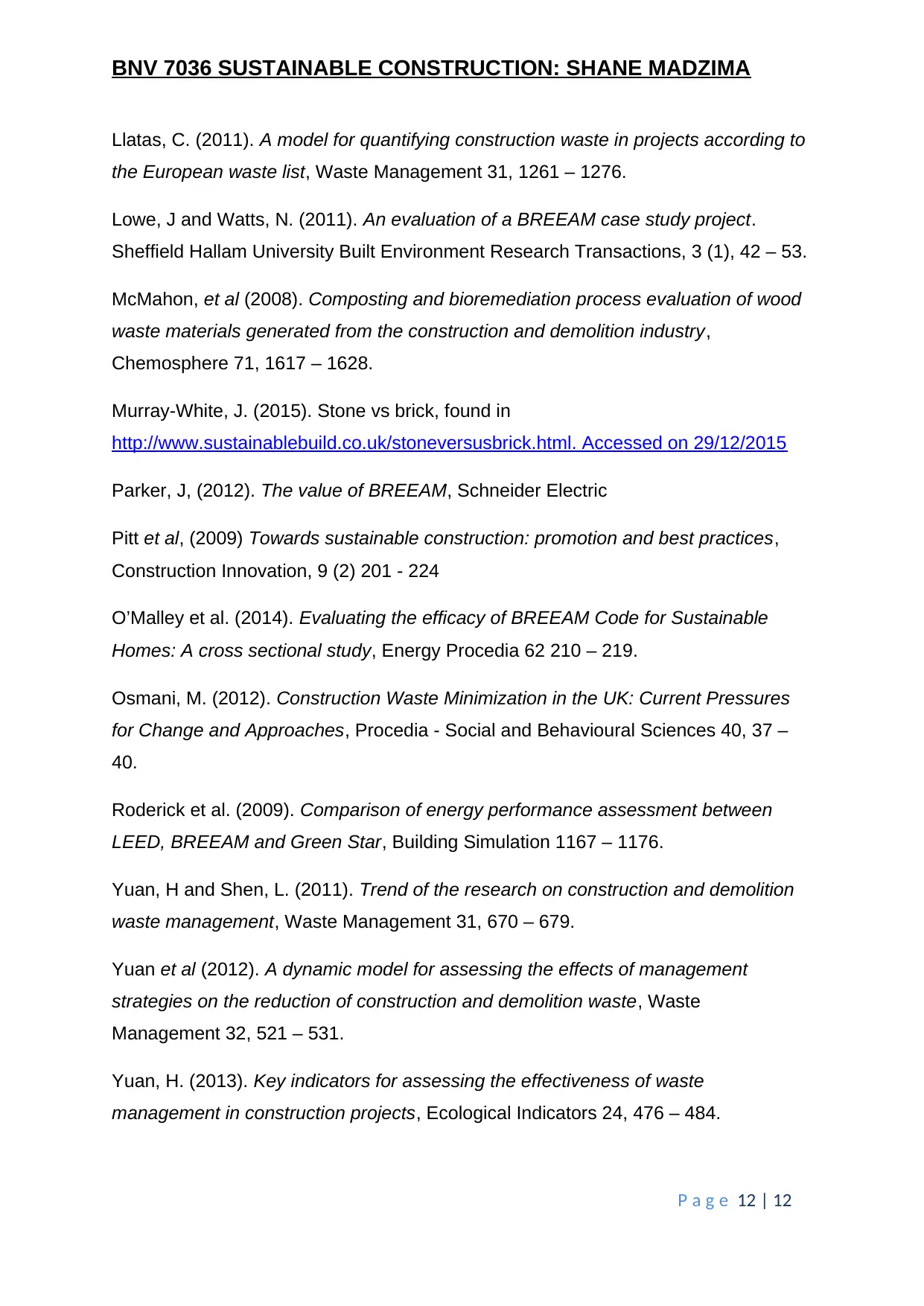
BNV 7036 SUSTAINABLE CONSTRUCTION: SHANE MADZIMA
Llatas, C. (2011). A model for quantifying construction waste in projects according to
the European waste list, Waste Management 31, 1261 – 1276.
Lowe, J and Watts, N. (2011). An evaluation of a BREEAM case study project.
Sheffield Hallam University Built Environment Research Transactions, 3 (1), 42 – 53.
McMahon, et al (2008). Composting and bioremediation process evaluation of wood
waste materials generated from the construction and demolition industry,
Chemosphere 71, 1617 – 1628.
Murray-White, J. (2015). Stone vs brick, found in
http://www.sustainablebuild.co.uk/stoneversusbrick.html. Accessed on 29/12/2015
Parker, J, (2012). The value of BREEAM, Schneider Electric
Pitt et al, (2009) Towards sustainable construction: promotion and best practices,
Construction Innovation, 9 (2) 201 - 224
O’Malley et al. (2014). Evaluating the efficacy of BREEAM Code for Sustainable
Homes: A cross sectional study, Energy Procedia 62 210 – 219.
Osmani, M. (2012). Construction Waste Minimization in the UK: Current Pressures
for Change and Approaches, Procedia - Social and Behavioural Sciences 40, 37 –
40.
Roderick et al. (2009). Comparison of energy performance assessment between
LEED, BREEAM and Green Star, Building Simulation 1167 – 1176.
Yuan, H and Shen, L. (2011). Trend of the research on construction and demolition
waste management, Waste Management 31, 670 – 679.
Yuan et al (2012). A dynamic model for assessing the effects of management
strategies on the reduction of construction and demolition waste, Waste
Management 32, 521 – 531.
Yuan, H. (2013). Key indicators for assessing the effectiveness of waste
management in construction projects, Ecological Indicators 24, 476 – 484.
P a g e 12 | 12
Llatas, C. (2011). A model for quantifying construction waste in projects according to
the European waste list, Waste Management 31, 1261 – 1276.
Lowe, J and Watts, N. (2011). An evaluation of a BREEAM case study project.
Sheffield Hallam University Built Environment Research Transactions, 3 (1), 42 – 53.
McMahon, et al (2008). Composting and bioremediation process evaluation of wood
waste materials generated from the construction and demolition industry,
Chemosphere 71, 1617 – 1628.
Murray-White, J. (2015). Stone vs brick, found in
http://www.sustainablebuild.co.uk/stoneversusbrick.html. Accessed on 29/12/2015
Parker, J, (2012). The value of BREEAM, Schneider Electric
Pitt et al, (2009) Towards sustainable construction: promotion and best practices,
Construction Innovation, 9 (2) 201 - 224
O’Malley et al. (2014). Evaluating the efficacy of BREEAM Code for Sustainable
Homes: A cross sectional study, Energy Procedia 62 210 – 219.
Osmani, M. (2012). Construction Waste Minimization in the UK: Current Pressures
for Change and Approaches, Procedia - Social and Behavioural Sciences 40, 37 –
40.
Roderick et al. (2009). Comparison of energy performance assessment between
LEED, BREEAM and Green Star, Building Simulation 1167 – 1176.
Yuan, H and Shen, L. (2011). Trend of the research on construction and demolition
waste management, Waste Management 31, 670 – 679.
Yuan et al (2012). A dynamic model for assessing the effects of management
strategies on the reduction of construction and demolition waste, Waste
Management 32, 521 – 531.
Yuan, H. (2013). Key indicators for assessing the effectiveness of waste
management in construction projects, Ecological Indicators 24, 476 – 484.
P a g e 12 | 12
1 out of 12
Your All-in-One AI-Powered Toolkit for Academic Success.
+13062052269
info@desklib.com
Available 24*7 on WhatsApp / Email
![[object Object]](/_next/static/media/star-bottom.7253800d.svg)
Unlock your academic potential
© 2024 | Zucol Services PVT LTD | All rights reserved.


